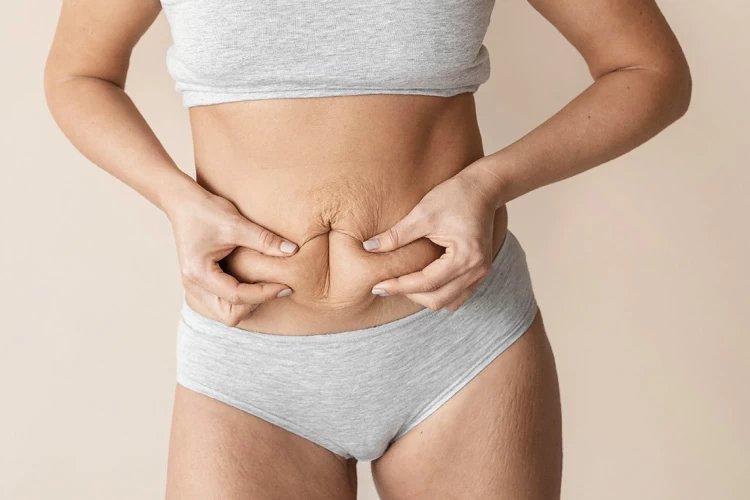Abdominoplasty, commonly known as a tummy tuck, is a popular cosmetic procedure. It addresses excess skin and fat in the abdominal area. While often yielding satisfactory aesthetic results, it is a significant surgical intervention. As with any surgery, tummy tucks carry inherent risks. Patients considering this procedure must understand these potential complications. Thorough pre-operative evaluation minimizes many risks. However, some complications can still arise during or after the surgery. These can range from minor issues to more serious health concerns. Understanding these potential challenges is crucial for informed consent.
Table of Contents
Tummy Tuck Recovery: Normal vs. Concerning Symptoms You Should Know
Distinguishing between normal post-operative symptoms and warning signs after tummy tuck surgery requires careful monitoring and understanding of the recovery process. Our clinical experience reveals that proper symptom recognition significantly reduces anxiety while ensuring timely intervention when necessary.
Normal Recovery Symptoms
Expected symptoms during tummy tuck recovery include:
- Mild to moderate pain at the incision site, typically managed with prescribed analgesics
- Swelling and bruising around the abdomen, gradually subsiding over 4-6 weeks
- Temporary skin tightness and reduced mobility in the abdominal area
- Light drainage from surgical drains, appearing clear to pale pink
- Fatigue and reduced energy levels for the first two weeks
Warning Signs Requiring Medical Attention
Recognising concerning symptoms forms a crucial component of managing tummy tuck complications effectively. Contact your surgical team immediately if you experience:
- Excessive bleeding that saturates dressings repeatedly
- Sudden increase in pain intensity despite medication
- Skin discolouration appearing unusually dark or mottled
- Temperature elevation above 38°C (100.4°F) persisting beyond 24 hours
- Foul-smelling discharge from incision sites
Monitoring Your Recovery Process
Follow these systematic steps for minimizing tummy tuck complications:
- Examine incision sites twice daily using clean hands and adequate lighting
- Document symptoms in a recovery journal, noting changes in pain levels and appearance
- Measure drainage output if drains are present, reporting significant increases
- Monitor vital signs including temperature and pulse rate during the first week
- Assess mobility levels ensuring gradual improvement without sudden deterioration
Understanding Tummy Tuck Surgery Side Effects
Tummy tuck wound healing problems typically manifest within the first two weeks post-operatively. Normal healing progresses with consistent improvement in comfort levels and gradual reduction of swelling. However, tummy tuck side effects requiring intervention include persistent drainage beyond expected timeframes, increasing rather than decreasing discomfort, and changes in wound appearance that deviate from normal healing patterns.
Recovery timelines vary significantly between individuals, with most patients experiencing substantial improvement by the sixth week. Regular communication with your surgical team ensures optimal outcomes while addressing concerns promptly throughout the healing process. The Tummy Tuck Recovery Process may involve monitoring for complications and infections that occur during or after tummy tuck, which require immediate medical attention to prevent further issues. Following post-operative care instructions meticulously can greatly enhance recovery and ensure the best possible outcome.
Tummy Tuck Infections: Prevention, Early Signs and Treatment Options
Operative site infection abdominoplasty represents one of the most significant complications following tummy tuck procedures. Infection rates typically range from 2-15% depending on patient factors and surgical conditions. Understanding prevention strategies and recognising early warning signs enables patients to seek prompt treatment and avoid serious complications.
Essential Prevention Strategies
Preventing tummy tuck incision infection begins with selecting a qualified plastic surgeon operating in accredited facilities. Proper surgical technique, sterile environments, and adherence to infection control protocols significantly reduce risk factors.
- Maintain strict wound hygiene using prescribed antiseptic solutions
- Follow prescribed antibiotic regimens exactly as directed
- Avoid submerging incisions in baths, swimming pools, or hot tubs
- Keep surgical sites dry and protected from contamination
- Attend all scheduled follow-up appointments for professional wound assessment
Identifying Early Infection Signs
Recognising signs of infection after tummy tuck requires systematic daily inspection of surgical sites. Early detection prevents progression to serious complications requiring hospitalisation or surgical intervention.
- Examine incision lines for increased redness extending beyond normal surgical margins
- Check for unusual warmth or heat radiating from wound areas
- Monitor for purulent discharge with yellow, green, or foul-smelling characteristics
- Assess pain levels – tummy tuck pain infection typically worsens rather than improves
- Record body temperature twice daily, noting any fever above 38°C
Normal Healing vs Infection Indicators
The following comparison helps distinguish between expected healing responses and concerning tummy tuck infection signs:
| Normal Healing | Infection Indicators |
|---|---|
| Mild pink discolouration | Bright red, spreading inflammation |
| Clear or light pink drainage | Thick, coloured, or malodorous discharge |
| Gradually decreasing discomfort | Increasing pain and tenderness |
| Stable body temperature | Fever, chills, or flu-like symptoms |
Post abdominoplasty infections typically manifest within the first two weeks following surgery. However, delayed infections can occur up to several months post-operatively, particularly in patients with compromised immune systems or underlying medical conditions.
Treatment Approaches
When tummy tuck wound infection develops, immediate medical intervention prevents serious complications. Treatment protocols vary based on infection severity, causative organisms, and patient-specific factors. Superficial infections often respond to topical antimicrobials and enhanced wound care, whilst deeper tissue involvement requires systemic antibiotics. Severe cases may necessitate surgical debridement, drainage procedures, or wound revision techniques to eliminate infected tissue and promote healing.
Seroma and Hematoma: Understanding Fluid Collection Complications
Fluid accumulation represents one of the most common complications following plastic surgery procedures. These post-operative collections manifest as distinct clinical entities that require careful nursing assessment and appropriate intervention strategies.
Pathophysiology and Development
Seromas and hematomas develop through different mechanisms following surgical trauma:
- Seroma formation occurs when lymphatic vessels become disrupted during tissue dissection, leading to serous fluid accumulation
- Hematoma development results from inadequate haemostasis or blood vessel injury during the operative procedure
- Extensive undermining of tissue planes increases the likelihood of both complications
- Poor surgical technique and inadequate drain placement contribute significantly to fluid collection risks
Clinical Recognition and Assessment
Early identification of fluid collections requires systematic nursing evaluation. The following detection methods guide clinical assessment:
- Physical examination reveals fluctuant masses or asymmetrical contours in the surgical area
- Percussion testing demonstrates characteristic fluid waves over collection sites
- Ultrasound imaging provides definitive confirmation of fluid presence and volume quantification
- Aspiration techniques allow for diagnostic sampling and therapeutic drainage when indicated
Comparative Analysis of Complications
The following table outlines the distinguishing characteristics between these fluid collection complications:
| Feature | Seroma | Hematoma |
|---|---|---|
| Fluid Type | Clear, straw-coloured | Dark, blood-tinged |
| Onset Timeline | 7-14 days post-operatively | 24-72 hours post-operatively |
| Consistency | Soft, fluctuant | Firm, tense |
| Pain Level | Mild discomfort | Moderate to severe pain |
| Treatment | Aspiration, drainage | Surgical evacuation often required |
Seromas typically present with gradual onset and minimal patient discomfort, whilst hematomas demonstrate acute development with associated pain and tension. Both complications require prompt recognition to prevent secondary issues such as wound dehiscence or compromised healing.
Management Protocols
Conservative management involves serial aspiration for seromas, whilst significant hematomas necessitate surgical evacuation. Compression garments provide mechanical support and reduce dead space formation. Our clinical experience demonstrates that early intervention prevents progression to more complex complications requiring extensive surgical revision.
Drainage systems remain in situ until output decreases to acceptable levels, typically less than 30ml per 24-hour period. Regular monitoring of drain characteristics and patient symptoms ensures optimal outcomes and reduces complication rates in post-operative plastic surgery patients.
Numbness and Nerve Damage: Will Sensation Return?
Sensory alterations following abdominoplasty procedures represent a well-documented phenomenon in plastic surgery practice. Our extensive clinical experience confirms that temporary numbness affects the majority of patients, typically manifesting in the abdominal region below the incision line.
Common types of sensory changes include:
- Complete numbness (anaesthesia) in specific abdominal zones
- Reduced sensation (hypoesthesia) across the treated area
- Tingling or burning sensations (paraesthesia)
- Hypersensitivity in peripheral regions
The anatomical basis for these changes involves the disruption of superficial sensory nerves during tissue manipulation and repositioning. Lateral femoral cutaneous nerves and superficial epigastric nerve branches frequently experience temporary interruption during the surgical process.
Recovery timeline follows predictable patterns based on our clinical observations:
- Initial 6-8 weeks: Complete numbness predominates, representing normal post-surgical response
- 3-6 months: Gradual sensation return begins, often described as tingling or pins-and-needles
- 6-12 months: Significant sensory improvement occurs in approximately 80% of patients
- 12-18 months: Final sensory outcome becomes apparent
Permanent sensory deficit affects approximately 15-20% of patients, typically confined to small areas of the lower abdomen. These permanent changes reflect complete nerve transection rather than temporary neuropraxia.
Several factors influence sensory recovery potential. Patient age significantly impacts nerve regeneration capacity, with younger individuals demonstrating superior recovery rates. Surgical technique modifications, including nerve-sparing approaches, enhance preservation of sensory function.
The regeneration process occurs at approximately 1mm per day along damaged nerve pathways. Peripheral nerves possess remarkable regenerative capacity compared to central nervous system structures, explaining the gradual improvement most patients experience.
Regular neurological assessment during follow-up appointments enables precise monitoring of sensory recovery progression and identification of atypical healing patterns.
Long-Term Scarring After Tummy Tuck: How to Minimize the Risk?
Abdominoplasty scarring represents a significant concern for patients considering this transformative procedure. Our collective experience demonstrates that proper scar management begins with understanding individual risk factors and implementing evidence-based prevention strategies.
Risk Factors for Excessive Scarring
Several factors contribute to problematic scar formation following tummy tuck procedures:
- Previous abdominal surgeries or trauma history
- Genetic predisposition to keloid or hypertrophic scarring
- Smoking status and nicotine exposure
- Diabetes or autoimmune conditions
- Age and skin elasticity characteristics
- Post-operative wound tension levels
Evidence-Based Scar Minimisation Protocol
Clinical evidence supports a structured approach to reducing cicatricial complications:
- Pre-operative optimisation includes smoking cessation 6-8 weeks before surgery and stabilising medical conditions
- Surgical technique refinement focuses on tension-free closures and appropriate tissue handling
- Early mobilisation protocols begin 24-48 hours post-operatively to promote healthy healing
- Topical scar management commences at 2-3 weeks using silicone-based products
- Long-term monitoring continues for 12-18 months to assess maturation patterns
Scar Management Comparison
The following table outlines different scar types and their corresponding management approaches:
| Scar Type | Characteristics | Primary Treatment | Expected Timeline |
|---|---|---|---|
| Normal | Flat, pale, soft | Silicone sheets/gel | 6-12 months |
| Hypertrophic | Raised, red, confined | Steroid injections | 12-18 months |
| Keloid | Extends beyond wound | Combination therapy | 18-24 months |
Normal scars respond well to conservative management, while hypertrophic scarring requires more intensive intervention. Keloid formation presents the greatest challenge, often necessitating multiple treatment modalities.
Advanced treatment options include laser therapy, microneedling, and fractional resurfacing for mature scars. Our experience indicates that patients achieving optimal outcomes combine multiple modalities with consistent long-term care protocols. Realistic expectations remain crucial, as complete scar elimination proves impossible, though significant improvement occurs in most cases.
Life-Threatening Complications: Understanding Serious Risks
Abdominoplasty procedures carry inherent risks that can escalate to life-threatening situations. Understanding these major tummy tuck complications enables patients to make informed decisions while recognising when immediate medical intervention becomes necessary.
Pulmonary embolism represents the most serious risk following abdominoplasty. This condition occurs when blood clots form in the legs and travel to the lungs, potentially causing fatal outcomes. Studies indicate that tummy tuck risks of death primarily stem from thromboembolic events, with mortality rates ranging from 0.02% to 0.16% in properly conducted procedures.
Severe bleeding complications constitute another critical concern. While minor bleeding remains common, massive haemorrhage requiring emergency intervention occurs in approximately 1-2% of cases. This complication can lead to hypovolaemic shock, requiring immediate blood transfusion and surgical intervention.
The following complications require immediate emergency attention:
- Sudden chest pain or difficulty breathing – indicates possible pulmonary embolism
- Excessive bleeding that soaks through multiple dressings within hours
- Signs of severe infection including high fever, rapid pulse, and altered mental status
- Severe abdominal pain with rigid abdomen suggesting internal complications
- Allergic reactions to anaesthesia or medications causing respiratory distress
Deep vein thrombosis frequently precedes pulmonary embolism, making early recognition crucial. Symptoms include severe leg pain, swelling, and warmth in the affected limb. Our collective experience demonstrates that patients with extended surgical times face increased thrombotic risks.
The table below summarises critical complications and their warning signs:
| Complication Type | Primary Warning Signs | Urgency Level |
|---|---|---|
| Pulmonary Embolism | Chest pain, shortness of breath, rapid pulse | Emergency |
| Severe Haemorrhage | Excessive bleeding, dizziness, pale skin | Emergency |
| Sepsis | High fever, confusion, rapid breathing | Emergency |
| Cardiac Events | Chest pain, irregular heartbeat, nausea | Emergency |
Anaesthetic complications present additional life-threatening risks. Malignant hyperthermia, though rare, can prove fatal without immediate recognition and treatment. Cardiovascular collapse during surgery requires immediate resuscitation measures.
Proper surgical facility selection significantly reduces life-threatening complications. Accredited surgical centres maintain emergency protocols, advanced monitoring equipment, and immediate access to intensive care facilities. Board-certified plastic surgeons possess extensive training in managing surgical emergencies and recognising early warning signs.
Patient selection criteria play a crucial role in minimising severe complications. Comprehensive pre-operative assessment identifies high-risk patients, allowing for appropriate risk stratification and modified surgical approaches. Patients with cardiovascular disease, clotting disorders, or significant medical comorbidities require enhanced monitoring protocols.
The abdominoplasty complications discussed here, while serious, remain relatively uncommon when proper surgical techniques and patient selection guidelines are followed. Understanding what can go wrong with tummy tuck procedures empowers patients to seek qualified surgeons and recognise emergency situations requiring immediate medical attention.
At CK Health Turkey, you can safely undergo tummy tuck (abdominoplasty) with our experienced plastic surgeons who utilize the highest quality equipment and the latest technologies and techniques. For more information, please contact our healthcare coordinators.



